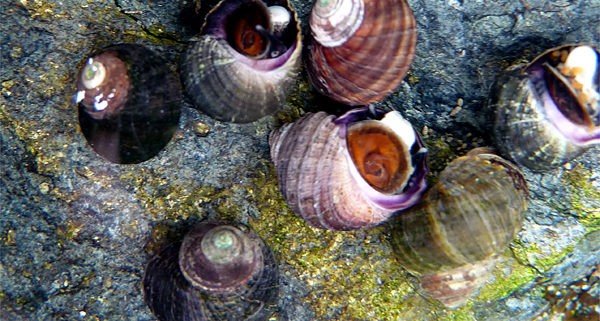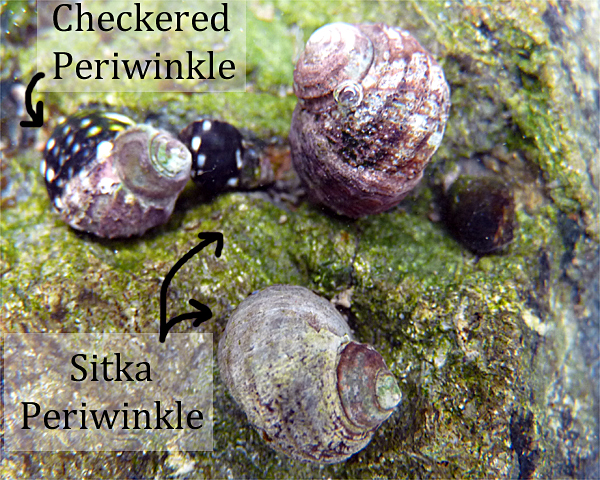Common Name: Sitka Periwinkle Scientific Name: Littorina sitkana Size Range: Up to 2cm (0.8 inches) long Identifying Features: The Sitka Periwinkle generally has a brown or grey shell, which is sometimes striped. They can close themselves inside their shells with a door, called an operculum. They slide around in their own mucus using their muscular foot. They have little eyes, antennae, and a mouth, which is full of tiny razor sharp teeth. Habitat: Sitka Periwinkles attach themselves to pilings, mangroves, seaweed, rocky shorelines, and beneath boats and docks using mucus. They are one of the few sea creatures that can breathe air, and when the tide is low, they close themselves up into their shells to prevent drying out. Despite this ability many end up dying due to drying out especially when exposed to high temperatures. They live on the Pacific Ocean, from Alaska to Baja, and also on the Atlantic coast. Food: Sitka Periwinkles are vegetarians. They feed mainly on filamentous algae but also eat films of diatoms, lichens and Rockweek (Fucus gardneri) . They scrape food off of surfaces with a hooked, chainsaw like structure of teeth called a radula. Impressively, they can replace up to seven rows of teeth daily! Most Sitka Periwinkles only eat every 2-3 weeks. Predators: Many animals prey on the Sitka snail, such as sea stars, crabs, sea anemones, and various water birds. One study found the main predators to be the Red Rock Crab (Cancer productus) and the Pile Perch (Rhacochilus vacca). To protect themselves, the snails close themselves into their thick armor like shells. Many hermit crabs will use the empty shell of the Sitka Periwinkle as their home. Life Cycle: Once yearly, males seek out mates. Often they can’t tell the difference between females and other males, and sometimes two males can be seen fighting, only to discover that the supposed female is in fact another male. Once fertilized by the male females lay 50-400 eggs in mucus bundles in tide pools. Once hatched, larvae are washed out to sea to grow. Young periwinkles look like miniature adults.
References Alaska Natural Heritage Program (2009, December 9). Sitka Periwinkle. Retrieved June 24, 2010 from http://aknhp.uaa.alaska.edu/zoology/species_ADFG/ADFG_PDFs/Invertebrates/Sitka_periwinkle_final_ADFG_2006.pdf Amsel, Sheri. Periwinkle Snail. Exploring nature educational resource. N.p., 2010. Retrived June 2, 2010 from http://www.exploringnature.org/db/detail.php?dbID=43&detID=1142 Anderson, Genny (2003). The Splash Zone. Marine science Retrieved June 3, 2010. http://www.marinebio.net/marinescience/03ecology/tpspl.htm (2007) Periwinkle Snail. Retrieved June 3, 2010 from http://www.snailfacts.net/periwinkle_snail/periwinkle_snail.html Periwinkle. Encyclopaedia Brittanica. Retrieved June 2, 2010 from http://www.britannica.com/EBchecked/topic/452111/periwinkle Video by Bea Wicker Photography by D. Young
Author: Bea Wicker






Leave a Reply
Want to join the discussion?Feel free to contribute!